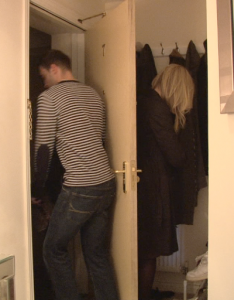 Rebecca Roberts-Hughes discusses new research on what people need and expect from their homes. The research is based on interviews with a number of households, each providing valuable anecdotal information that will be considered in the design and building of new and better housing.
Rebecca Roberts-Hughes discusses new research on what people need and expect from their homes. The research is based on interviews with a number of households, each providing valuable anecdotal information that will be considered in the design and building of new and better housing.
“If you’re buying a new home as a young family you’d want to be able to evolve with that space.” This was the view of one first time buyer who took part in our new research The way we live now, which aimed to find out what people need and expect from their homes today. The Royal Institute of British Architects (RIBA) asked Ipsos MORI to film five households and hold a series of discussion groups with prospective buyers, to find out how people use the rooms and spaces in their homes, and what they look for when choosing a new place to live.
With new government policies advocating good quality homes, the coalition has made it clear that Britain deserves better (see the Housing Strategy, November 2011 and National Planning Policy Framework, March 2012). But what constitutes a ‘good quality home’ in the 21st century needs redefining. Housing quality standards are a starting point, and these are currently being reviewed for the government by a cross-industry working group. Many of these standards need updating for modern life. Even the new space standards introduced in London by Mayor Boris Johnson last summer were reported as Parker Morris plus 10 per cent. The Parker Morris standards were based on research from the 1950s, which set out minimum design criteria for council homes and even specified the need for an indoor toilet. So what has changed by 10 per cent over the last sixty years?
 The way we live now analyses the filmed evidence and generative discussions with members of the public to get to grips with what people look for in a home, and also the areas people need to socialise, eat as a household, use modern technology such as wireless internet connections, relax, recycle, work from home or supervise homework, and many more activities.
The way we live now analyses the filmed evidence and generative discussions with members of the public to get to grips with what people look for in a home, and also the areas people need to socialise, eat as a household, use modern technology such as wireless internet connections, relax, recycle, work from home or supervise homework, and many more activities.
The report reveals that a desirable home is a social space that typically needs a large living area, preferably a flexible space that can be used for socialising with other members of the household and for entertaining guests. One woman told us “it’s the sociability… I’d design a house so that I can fold the bed away and stuff so that I can have a party and have people over to eat, although it’s a box.” People also looked for a home that is light, with large windows. “Artificial light especially in day time can be depressing,” one of the filmed participants explained.
People from a range of households and age groups participated in the research, and no single layout could cater for all of them at once. Life stage had an impact, with older people looking for homes that would remain accessible in the future, and families had other specific needs. Whilst some households preferred the flexibility of open plan living, one man explained, “I get the option of working from home quite regularly but it’s tricky in an open plan house with kids.”
With no one-size-fits-all design, local authorities preparing their Local Plans will need to start thinking about how to deliver a choice and range of housing types. Meeting Britain’s housing need is about more than getting the numbers right.
There are also implications for the relationship between public policy and the marketplace. Participants were asked what information and regulation they thought was needed, to address some of the issues that arose during the discussion groups. The consensus reached was for a cross-industry independent body to regulate bedroom sizes, environmental performance and noise insulation in new homes. It was also thought that this group should provide free information so that consumers could compare the performance of homes. As one participant explained, “[My friend’s] got … two bedrooms and a box room that you can’t do anything in … it does fit a single bed in but then there’s no room to do anything else in it, so it just seems like a completely pointless room.” Environmental performance and noise insulation were elements of quality which people found hard to evaluate, so information direct from the industry was thought to be useful in helping people make informed choices.
 One of the more surprising revelations from the research was the lack of storage people reported or showed in the films. One first time buyer explained that to take advantage of buy one get one free offers she would have to find creative places to store the money saving deals: “we just leave it in the car.” A family in Banbury experienced similar problems, with the mother explaining “I don’t have anywhere to put the Hoover… we don’t use the bathroom toilet downstairs. It is mainly for guests and stuff. The Hoover stays in there.” People found ingenious solutions to inappropriate storage, but a well designed home should not force people into complex habits. This is something everyone can relate to, and people have been uploading photographs of their vacuum cleaner in the place that they store it on to the RIBA HomeWise campaign facebook page.
One of the more surprising revelations from the research was the lack of storage people reported or showed in the films. One first time buyer explained that to take advantage of buy one get one free offers she would have to find creative places to store the money saving deals: “we just leave it in the car.” A family in Banbury experienced similar problems, with the mother explaining “I don’t have anywhere to put the Hoover… we don’t use the bathroom toilet downstairs. It is mainly for guests and stuff. The Hoover stays in there.” People found ingenious solutions to inappropriate storage, but a well designed home should not force people into complex habits. This is something everyone can relate to, and people have been uploading photographs of their vacuum cleaner in the place that they store it on to the RIBA HomeWise campaign facebook page.
The RIBA asked Ipsos MORI to undertake this research to create a national evidence base about consumer wants and needs, to inform the design of modern homes. This evidence base will be used by the Future Homes Commission, an independent panel conducting an inquiry into how Britain can build more and better homes. The Commission is also gathering evidence from the house building industry, planners and architects, and will make recommendations in the autumn.
Note: This article gives the views of the author, and not the position of the British Politics and Policy blog, nor of the London School of Economics. Please read our comments policy before posting.
Rebecca Roberts-Hughes is the Policy Manager at the Royal Institute of British Architects (RIBA). Her current role is to influence government policy and the built environment industry to improve architectural quality, leading on housing policy and managing the RIBA’s think tank, Building Futures. She is one of the co-authors of The way we live now.






